Winter Giants: Celebrate South Africa’s Whale Season
Every winter, South Africa’s coastline transforms into a spectacular stage for some of the ocean’s most magnificent creatures. From playful breaches to heartwarming glimpses of mothers and calves, whale season is a breathtaking reminder of nature’s magic.
Dive into our special series and discover fascinating facts, epic migrations, secret whale songs, and the incredible conservation efforts that keep these gentle giants safe. Whether you're a seasoned spotter or a first-time whale watcher, there’s something here to amaze you.
Let’s explore the wonder of South Africa’s winter visitors — one splash at a time!
The Great Migration: Why Whales Choose South Africa
Every year, starting in June, Southern Right whales, Humpback whales, and Bryde’s whales start appearing along South Africa’s coastline. They have just completed a grueling journey from the icy feeding grounds of Antarctica, swimming up to 10,000 kilometers to find the warmer waters they need.
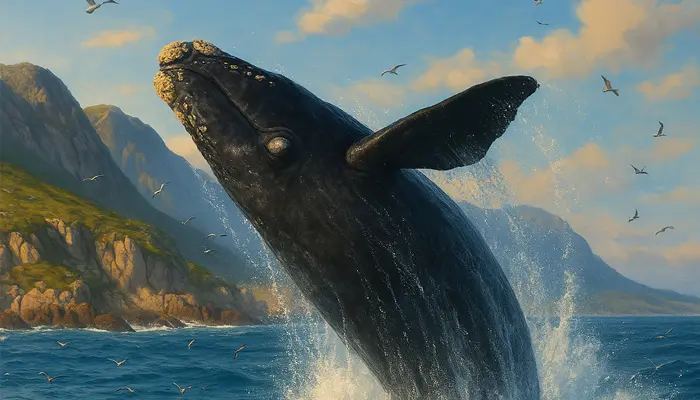
Why leave the abundant Antarctic feeding zones? It’s all about survival. In cold Antarctic seas, newborn whale calves would struggle to maintain their body temperature. South Africa’s coastal waters, warmed by the Agulhas current, provide the ideal safe haven. Here, calves are born and nursed in relative warmth, without the risk of freezing.
But it’s not just the temperature that attracts these giants. Our coastline offers secluded bays, calm waters, and shallow coves — the perfect "nurseries" where mothers can protect and feed their young away from predators.
Interestingly, Southern Right whales even have a "memory" of these birthing sites. Scientists believe they return to the same areas where they were born, year after year, a phenomenon known as "site fidelity." That means the whales visiting us today might have been born in our waters decades ago!
The migration has been happening for centuries, long before humans even understood the rhythm of the seas. Now, towns like Hermanus celebrate their arrival with festivals, whale-watching tours, and even a dedicated whale crier to announce sightings to visitors.
So when you spot that massive tail slap or a baby calf rolling beside its mother, remember: you're witnessing an ancient, beautiful tradition that has been happening along our coast for generations.
🐋 Fun Fact!
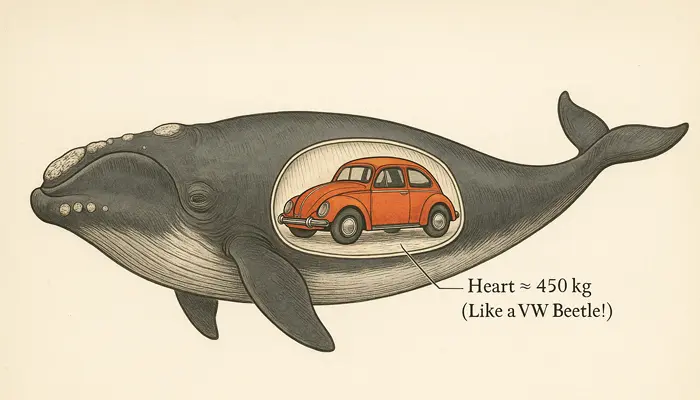
A Southern Right whale’s heart weighs about 450 kilograms — that's about the same as a small car like a Volkswagen Beetle!
Whale Spotting 101: Best Places for a Front-Row Show
If you think you need to set sail on the open seas to spot whales, think again! South Africa is one of the top places for land-based whale watching — meaning you can stay dry and still get an incredible view of these ocean giants.

One of the best-known spots is Hermanus, often called the “Whale Watching Capital of the World.” Here, whales come so close to the shore that you can hear them breathe. Every year, the town hosts the Hermanus Whale Festival — a lively celebration of music, food, and, of course, whale spotting.
Next up is Plettenberg Bay, where you can often see Humpback whales performing their acrobatics right from the beach. The bay’s dramatic cliffs and wide views make it a prime location.
De Hoop Nature Reserve is another hidden gem. With its peaceful beaches and wild scenery, it’s one of the best places to see Southern Right whales calving and nursing their young close to shore. Fewer crowds mean you might have the whales all to yourself!
And don’t forget about Cape Agulhas, the southernmost tip of Africa. Here, the whales glide past where two oceans meet — a truly magical sight, especially at sunset.
Tip: Bring binoculars, pack a picnic, and dress warmly — the best sightings often happen when you’re relaxed and not rushing.
In Hermanus, you might even hear the famous Whale Crier — the only one of his kind in the world. He walks along the shore blowing a kelp horn to alert visitors when whales are nearby. Talk about a VIP whale alert!
Whether it’s a tail slap, a full breach, or a playful calf nudging its mother, seeing these giants in the wild is a once-in-a-lifetime experience you’ll never forget.
🐋 Fun Fact!
Hermanus is home to the world’s only Whale Crier, who uses a kelp horn to announce whale sightings to excited visitors!
Meet the Stars: South Africa’s Famous Whale Species
First up is the Southern Right whale, the true heavyweight superstar of the South African coastline. These giants can grow up to 18 meters long and weigh up to 80 tons. They’re easily recognized by their huge, V-shaped blow and the rough patches of skin (called callosities) on their heads. Southern Rights are friendly, often breaching, waving, and even approaching boats to say hello!
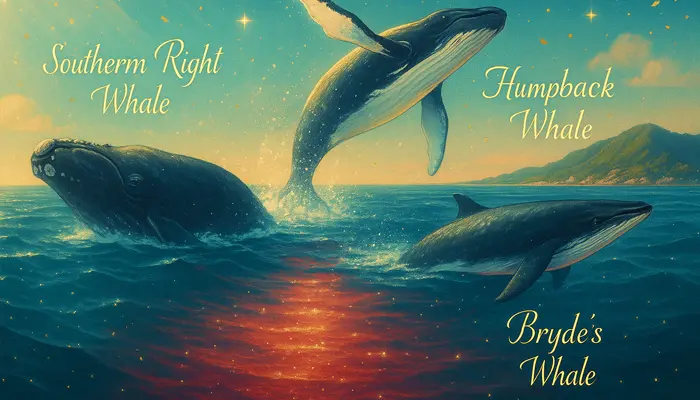
Next in the spotlight are the Humpback whales. Famous for their spectacular breaches and elaborate songs, Humpbacks are the acrobats and singers of the whale world. Their massive flippers can be one-third the length of their bodies, making them easy to spot when they leap from the water in a jaw-dropping display.
Then there’s the mysterious Bryde’s whale — a more elusive guest. Bryde’s (pronounced "broo-dess") are faster and sleeker than the others, often darting quickly through the waves. They prefer warmer waters and are a bit shy, making sightings extra special. Look for a triple-ridge pattern on their heads, which sets them apart.
How to tell them apart?
-
Southern Rights: V-shaped blow, slow and surface-loving.
-
Humpbacks: Splashy jumpers with long flippers.
-
Bryde’s Whales: Quick, sleek, and camera-shy.
Whichever you spot, each encounter promises a brush with one of the ocean’s most fascinating giants. Bring your binoculars and keep your cameras ready — these celebrities don’t mind posing for a photo!
🐋 Fun Fact!
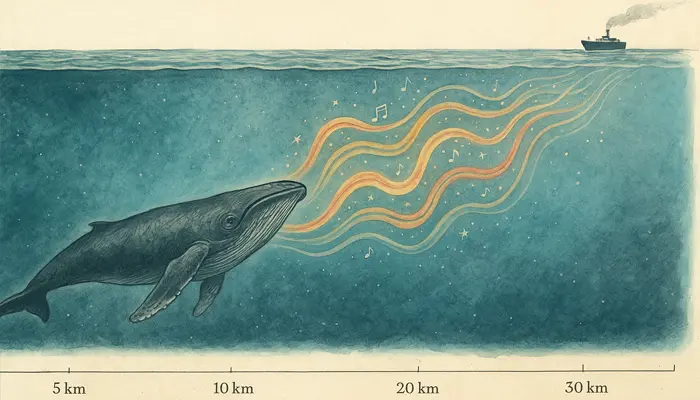
A Humpback whale’s song can travel over 30 kilometers underwater!
These underwater concerts are some of the longest and most complex songs in the animal kingdom.
Ocean Acrobats: How Whales Pull Off Their Epic Jumps
First things first: breaching is when a whale leaps out of the water, often twisting mid-air before crashing down in a spectacular splash. It’s one of the most iconic sights you can witness during South Africa’s whale season.
But why would a whale, weighing up to 40 tons, bother to jump? Scientists believe there are several reasons:
-
Communication: The splash can be heard underwater from kilometers away — it’s a whale’s version of sending a loud message!
-
Parasite Removal: Jumping and splashing might help whales knock off unwanted hitchhikers like barnacles.
-
Play: Just like humans, whales seem to enjoy having fun — especially young calves who often breach repeatedly.
-
Courtship Displays: During mating season, the most impressive jumpers might win the heart of a mate.
Aside from breaching, whales show off with other acrobatic moves:
-
Tail Slapping: Smacking their tails hard on the water’s surface to create sound and splash.
-
Spy Hopping: Lifting their heads vertically out of the water to look around.
-
Lobtailing: Smashing their huge tail flukes on the surface, sometimes repeatedly.
South Africa’s coastline, especially places like Hermanus and De Hoop, offers ideal viewing. With whales swimming close to shore, you can often see breaches and splashes without even getting your feet wet!
Every jump is a breathtaking reminder of the power, grace, and mystery of these gentle giants — and if you’re lucky enough to catch one, it’s an image you’ll never forget.
🐋 Fun Fact!
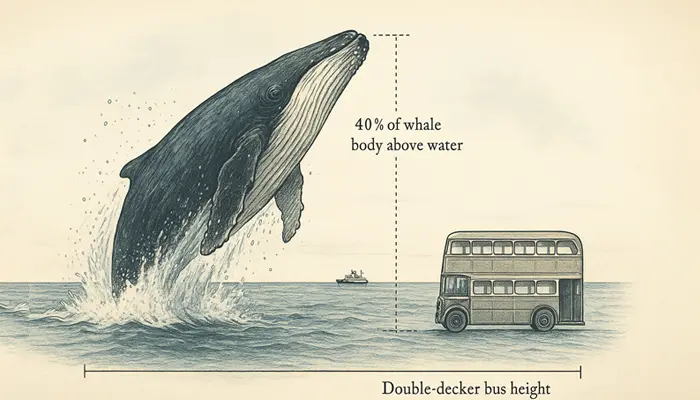
A full-grown whale can launch 40% of its body out of the water when breaching — that’s like a double-decker bus leaping out of the sea!
Saving the Giants: South Africa’s Role in Whale Conservation
In the 19th and early 20th centuries, whales were hunted mercilessly for their blubber, oil, and baleen. Southern Right whales got their name because they were considered the "right" whales to hunt — slow-moving, full of oil, and easy to catch.
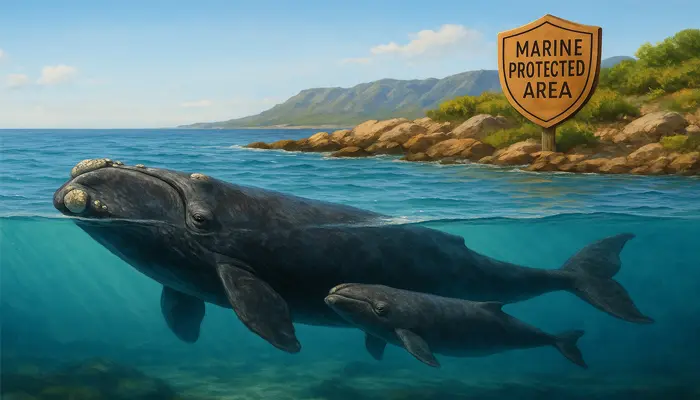
By the early 1900s, Southern Right whale populations had crashed by more than 90%. The oceans fell eerily silent, and the future of these incredible creatures hung by a thread.
Thankfully, in 1935, the hunting of Southern Right whales was banned, and global efforts to protect whales gained momentum. South Africa has since become a leader in whale conservation, setting up Marine Protected Areas (MPAs) where whales can migrate, mate, and nurse their young safely.
Today, spots like the De Hoop MPA and Walker Bay Whale Sanctuary offer whales a safe haven along their migratory routes. Strict regulations on boat approaches and responsible whale-watching tourism have also helped populations slowly recover.
Eco-tourism has transformed whales from hunted targets into treasured attractions. In Hermanus and Plettenberg Bay, thousands of visitors come every year just to witness these gentle giants — supporting local economies while fostering love and respect for wildlife.
Citizen science projects, where everyday people report whale sightings or help monitor populations, have become another vital tool in protecting these species.
While challenges like climate change and ocean pollution remain, South Africa’s coastline stands today as a symbol of hope — proof that, with care and effort, even the greatest giants of the natural world can make a comeback.
🐋 Fun Fact!
Each Southern Right whale has white belly patches that are completely unique, just like a human fingerprint — no two whales have the same markings!



